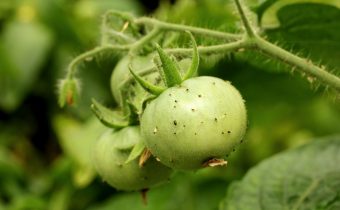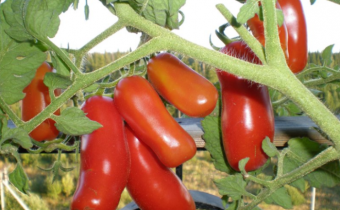How to get rid of whitefly on tomatoes
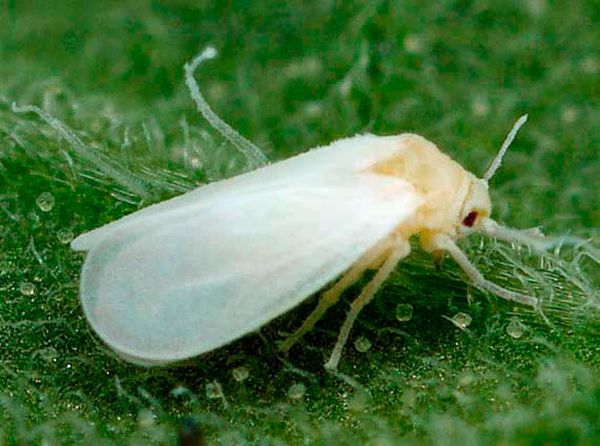
Greenhouse tomatoes most often suffer from sabotage of various insects. The whitefly is a frequent guest on tomato beds, its destructive effect affecting the lion's share of the landings.
Insect description
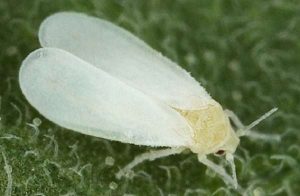 The whitefly is a microscopic flying insect (body is 2-3 millimeters long), originating from the same-winged family. Its tiny body is colored yellowish, and a pair of wings, which are twice as large as the insect itself, have a whitish-powdery tint. From a distance, whitefly clusters resemble aphids. Sticky sugary discharge, which leaves behind a pest, soot mushroom is formed, which bears great harm to the tomato bush.
The whitefly is a microscopic flying insect (body is 2-3 millimeters long), originating from the same-winged family. Its tiny body is colored yellowish, and a pair of wings, which are twice as large as the insect itself, have a whitish-powdery tint. From a distance, whitefly clusters resemble aphids. Sticky sugary discharge, which leaves behind a pest, soot mushroom is formed, which bears great harm to the tomato bush.
The whitefly likes to settle not only on tomato bushes, but also on cucumbers, eggplants and other vegetable crops.
Females lay eggs directly on the plants, or rather on the lower part of the leaves. In one laying you can count from 130 to 200 eggs. During the season, up to 15 generations of new whiteflies appear. Pale green flat, covered with outgrowths of needle-like larvae appeared to the world are very voracious. They feed on the juices of the leaf plate, as a result of which it dries out and falls quickly. After the spirit of the molts, the larvae turn into so-called nymphs, from which adult individuals fly out after a couple of weeks.
The humid and warm climate of the greenhouse is an ideal place for the whitefly to spread. When the temperature drops to +10 degrees, the adults die, while the eggs are able to withstand even frost.
The whitefly is a peddler of viral infections.
Signs of a pest
The whitefly appears on the bushes already 10-14 after the transplanting. It is quite simple to notice a whitefly colony in greenhouse conditions, as the pest attacks tomatoes throughout the flock. From this above the bushes you can see a white swarm of midges, 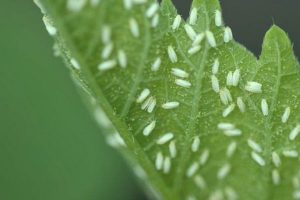 which, upon closer inspection, turns out to be a whitefly.
which, upon closer inspection, turns out to be a whitefly.
The underside of the leaves is completely covered with small yellowish clusters - egg clutches. And the "lunch" places of the whitefly are covered with a viscous whitish dot bloom - the product of insect life. Wrecking, along with the development of an infection, retards the development of plants. Stem atrophy occurs. The foliage turns yellow at the edges, twists, dries out. Rotting ring stains appear on the fruit.
Methods of struggle
It is difficult to get rid of the omnipresent whitefly, as its population is growing rapidly throughout the summer. Therefore, it is necessary to systematically combat the small dirty dog systematically throughout the growing season of tomato bushes, competently applying chemical, biological, mechanical and, of course, folk methods.
Biological methods
The most safe and effective methods that also do not require large investments. Why whitefly is not very common in open ground? The answer is simple: because in exposed areas, she herself is in danger. She loves to feast on God 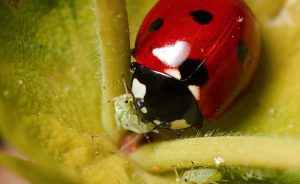 ladybugs, zlatoglazki and other predatory insects. It is difficult for them to get into the greenhouse, and therefore the whitefly feels at ease there.
ladybugs, zlatoglazki and other predatory insects. It is difficult for them to get into the greenhouse, and therefore the whitefly feels at ease there.
If you want to get rid of the annoying midge as soon as possible, then it is enough to add her biological enemies to the greenhouse - a dozen ladybugs (or other insects, such as macrolofus bugs, ecrasia, horsemen), which quickly catch all flying individuals.
For a more sophisticated hunt, a predator-enkarsia will be suitable, which will “solve the problem” with the young offspring of the whitefly. He lays eggs directly into her larvae, and then feeds on them. Will only get rid of adults.
Do not place cow dung under tomatoes - it makes the soil fertile for the settlement of various pests in it.
A good help in pest control is fumigation of the greenhouse. It is carried out during the preparation of the greenhouse for planting. For processing prepare a variety of mixtures. Fumigation means include:
- tobacco shashka;
- a candle of sulfur;
- smoke bomb
Such a manipulation allows you to get rid of pests of all ages.
Folk methods
The use of folk remedies is often effective in those cases if the whitefly has just appeared and did not have time to postpone the offspring. To this end, the tomatoes are sprayed with various decoctions and infusions of herbs that the insect does not tolerate. In addition, they are completely harmless to plants and humans, you can use them several times per season.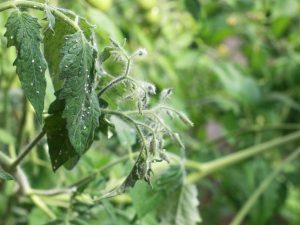 One of the "tasteless" means is an infusion of garlic or tobacco. It repels the insect and the smell of yarrow on the leaves of a tomato bush.
One of the "tasteless" means is an infusion of garlic or tobacco. It repels the insect and the smell of yarrow on the leaves of a tomato bush.
A mixture of dandelion (roots) or aloe, caught on tomatoes also causes a whitefly disgust, and it flies away forever in search of new food. Well, everyone's favorite soap solution will cover the leaves with a barely noticeable film that will reliably protect the tops from various pests.
Before treating plants, it is necessary to remove plaque and adult moths from greenery.
Mechanical methods
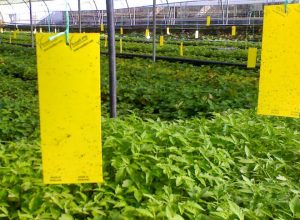 They are considered complementary, but, as proven by practice, they work very effectively. If a different flying animal has just started up in the greenhouse, then it can be assembled “manually”, or rather on sticky traps (flypaper for flies or made by hand with cardboard cardboard baits with the addition of a sticky layer - honey). Bright plates hung in different parts of the greenhouse will attract attention and “catch” pests. It will only be necessary to remove the affected fragments from the tomato and burn them outside the greenhouse. If eggs are found, they can be removed with a sponge moistened with soapy water.
They are considered complementary, but, as proven by practice, they work very effectively. If a different flying animal has just started up in the greenhouse, then it can be assembled “manually”, or rather on sticky traps (flypaper for flies or made by hand with cardboard cardboard baits with the addition of a sticky layer - honey). Bright plates hung in different parts of the greenhouse will attract attention and “catch” pests. It will only be necessary to remove the affected fragments from the tomato and burn them outside the greenhouse. If eggs are found, they can be removed with a sponge moistened with soapy water.
Studies have shown that insects are attracted to blue and yellow. Therefore, all the bait perform exactly in this color scheme.
Chemicals
And finally, if all other methods did not show proper results, heavy artillery is used. Chemicals are very effective in controlling greenhouse pests, but at the same time they are toxic, and therefore they must be used carefully and only before the maturation of the tomato. Otherwise, poison will fall on the fruit.
Chemical treatment is stopped 21 days before harvest.
Basically, all insecticides help cope with several types of insects at once. So,  for example, the drugs Actellic, Malathion, Aktara, Cypermethrin, Iskra-M, Talstar also save from bedbugs and aphids. The well-known drugs of directional action also include: "Verticillin", "Confidor", "Rovikur", "Mospilan", "Pegas", "Fufanon". In the case of severe damage to blood-suckers, the treatment is repeated 2-3 times, but only according to the instructions. Thoughtless use of chemistry can lead to crop damage.
for example, the drugs Actellic, Malathion, Aktara, Cypermethrin, Iskra-M, Talstar also save from bedbugs and aphids. The well-known drugs of directional action also include: "Verticillin", "Confidor", "Rovikur", "Mospilan", "Pegas", "Fufanon". In the case of severe damage to blood-suckers, the treatment is repeated 2-3 times, but only according to the instructions. Thoughtless use of chemistry can lead to crop damage.
Of the known means, the best are aerosols Kra-Deo, Super.
In addition to chemical preparations with whitefly, such fumigators as “Biotlin” and “Warrant” can cope.
Prevention
In the fight against the whitefly, all means are good, but it is better not to allow an annoying pest to put on tomato plants at all. Compliance with preventive measures will significantly reduce the risk 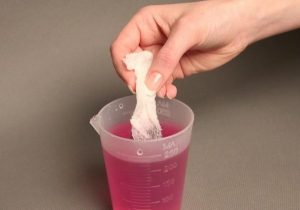 insect appearance and help preserve the crop.
insect appearance and help preserve the crop.
Prevention includes:
- seed treatment before sowing manganese solution;
- destruction of weed after harvest;
- deep soil digging in the offseason;
- embedding into the soil only overheated organic matter;
- not leaving dung heaps for the winter is a great place to hibernate the whitefly;
- maintaining the distance between the seedlings for better air circulation;
- greenhouse microclimate control (regular airing, competent watering);
- the purchase of varieties resistant to diseases and pests;
- entering into the wells when planting seedlings handfuls of chicken manure - this will increase the immunity of the tomato;
- regular tillage - weeding, loosening, airing.
Conclusion
Each gardener chooses a way to get rid of the pest, depending on the growing conditions of tomatoes and the number of insects. Methods can be combined with each other or used locally. The main thing is to do everything on time and following the instructions - only then can you defeat the enemy.


